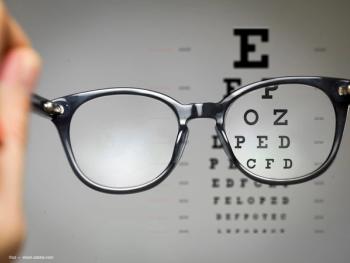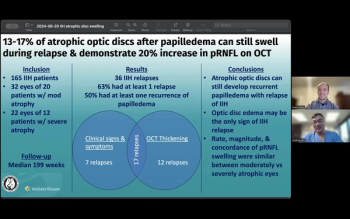
The investigators found that the premature births to be associated with vascular changes on ocular coherence tomography-angiography.

The investigators found that the premature births to be associated with vascular changes on ocular coherence tomography-angiography.

Investigators conducted a retrospective review that spanned 10 years with the goals of describing the clinical characteristics of choroidal metastasis in this patient population and report treatment outcomes after targeted therapy compared with conventional radiotherapy and/or chemotherapy.

The “Triangle sign” seen on ultrasound is a “distinctive and reliable” ultrasound feature for differentiating total choroidal detachments and suprachoroidal hemorrhages.

Funds from the Inasmuch Foundation and The Samuel Roberts Noble Foundation will support the purchase of equipment, including computerized eye simulators, a laser injector, and a device for measuring the electrical resistance of cells.

The meetings support the company’s submission for its bioengineered corneal implants to eliminate corneal blindness.

Chen and colleagues conducted a longitudinal study that included patients with high myopia who were followed for 10 years. Detailed ophthalmic examinations were conducted at the baseline and follow-up visits that included measurements of the BCVA and visual fields in 568 eyes of 284 patients.

The NeurEYE research team will use millions of eye scans from Scottish optometrists to create the data set.

The treatment showed stability or improvement in the Diabetic Retinopathy Severity Scale (DRSS) and generally the drug was well tolerated.

ARCATUS or ARVN001, in Greater China, South Korea, Australia, New Zealand, India and the ASEAN Countries is formally known as XIPERE in the United States and was developed by Clearside Biomedical.

The NPI-001 (N-acetylcysteine amide) tablets are a proprietary investigational therapy for the treatment of patients with retinitis pigmentosa.

Topline data results are expected in February 2025.

Changes can result in bacterial contamination, loss of drug activity, and inflammation

Following the switch from multifocal to single-vision contact lenses, axial elongation increased by 0.03 mm/year, and myopia progressed at a rate of −0.17 D annually after switching to single-vision lenses.

Linsitinib is being evaluated in patients with active, moderate to severe thyroid eye disease (TED).


Andrew G. Lee, MD, and Drew Carey, MD, return for this latest episode of the NeuroOp Guru to discuss whether a dead nerve can swell, focusing on the condition of papilledema caused by elevated intracranial pressure.

The iDose platform is designed to address ubiquitous patient non-adherence and chronic side effects associated with topical medications by providing 24/7 release of medication.

RayTrace has been utilized globally by surgeons since 2008.


The phase 1 clinical trial is a multicenter, open-label, dose-escalation study to assess drug safety via intravitreal injection in 3 cohorts.

Cost among other factors may deter patients from screening, especially in rural and low-resource settings.

The trial evaluated ONS-5010 in wet age-related macular degeneration patients, and the company plans to resubmit a Biologics License Application in the first quarter of 2025.

Study sees a positive association between the dietary inflammatory index (DII) and non-refractive visual impairment among US populations

The funding will support activities like formal pharmacology and toxicology testing.

The new funding will allow the company to complete its ongoing Phase 2 trial of proprietary nanomedicine, migaldendranib, in patients with wet AMD and DME

Dr. Frenkel highlights a comprehensive program that covers the latest breakthroughs in glaucoma and cataract surgery to in-depth discussions on AI, retinal treatments, and new drug-delivery platforms, all set against the backdrop of Snowmass, Colorado.

The launch follows a CE Mark received late last year.


The company will prioritize its cash in funding its ongoing Phase 1/2 PRISM clinical trial and Phase 3 4FRONT program.

With this addition, Zeiss completes the Corneal Refractive Workflow, which already includes Visumax 800 and SMILE pro.